Text
AgriNext Conference 2025: Cultivating the Future of Agriculture in the UAE
The AgriNext Conference & Awards 2025 is set to return to Dubai on November 5–6, bringing together the brightest minds and latest innovations in agri-tech. Hosted at the Le Méridien Dubai Hotel & Conference Centre, this landmark event aims to reshape the agricultural landscape through cutting-edge technology, sustainable practices, and global collaboration.
As agriculture faces challenges from climate change, population growth, and resource limitations, this event stands as a beacon for forward-thinking solutions that combine technology with ecological responsibility.
What to Expect at AgriNext 2025
🌱 Visionary Speakers from Across the Globe
This year’s conference welcomes a dynamic lineup of global leaders, entrepreneurs, researchers, and innovators. Attendees will gain valuable insights from those at the forefront of vertical farming, biotechnology, sustainable food systems, AI in agriculture, and more.
Each speaker will offer practical knowledge and forward-looking strategies designed to solve today’s most urgent agricultural challenges.
🧠 Transformative Sessions and Interactive Workshops
The event will feature a robust schedule of:
Panel Discussions on topics like digital transformation in farming, climate-resilient crops, and global food security.
Expert Presentations exploring themes such as precision agriculture, aquaculture innovations, and the role of AI in yield optimization.
Hands-On Workshops focusing on vertical farming, sustainable aquaculture, and new technologies in soil and crop management.
These sessions are designed to equip professionals with actionable strategies and inspire collaboration.
🏆 Honoring Innovation with the Excellence in Agriculture Awards
The conference will also host the Excellence in Agriculture Awards ceremony, recognizing individuals and organizations that have made significant contributions to sustainable agriculture, innovative farming solutions, and social impact within the agri-tech ecosystem.
This celebration of excellence highlights the creativity and commitment of those leading the charge toward a smarter agricultural future.
🌐 Meaningful Networking Opportunities
AgriNext 2025 is expected to welcome over 1,000 participants from across the agricultural value chain, including government officials, startup founders, investors, technologists, and researchers.
The conference offers numerous opportunities to:
Build strategic partnerships
Exchange ideas with top industry professionals
Explore investment and growth avenues
Discover emerging startups and disruptive technologies
Why Attend AgriNext 2025?
Stay Ahead of Industry Trends: Learn about the technologies and practices shaping the next decade of farming.
Connect with Leaders and Innovators: Meet change-makers who are redefining global agriculture.
Ignite Business and Research Collaborations: Find the right partners to accelerate your impact.
Gain Practical Knowledge: Take home tools, insights, and strategies you can immediately apply.
Showcase Your Work: Share your innovations with a global audience of industry stakeholders.
AgriNext 2025 isn’t just a conference—it’s a movement driving the evolution of agriculture through science, technology, and sustainability.
How to Participate
There are many ways to be part of this groundbreaking event:
Attend as a Delegate to access keynotes, sessions, and networking activities
Apply to Speak and share your expertise with a global audience
Exhibit Your Innovations and showcase your solutions to potential clients and partners
Nominate Achievers in the agricultural sector for the Excellence in Agriculture Awards
Whether you are a policymaker, innovator, investor, academic, or farmer, AgriNext 2025 offers a platform to contribute to the future of agriculture. Join the movement and help shape a smarter, more sustainable world.
0 notes
Text
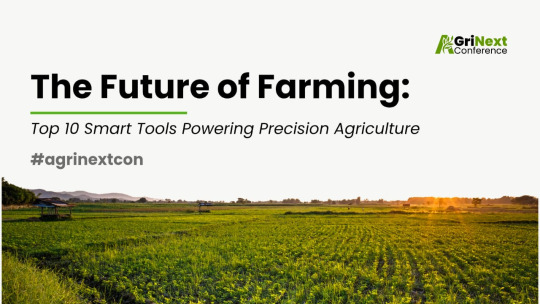
Precision Agriculture is the fastest growing agricultural technology in nowadays. Their are many tools for Precision Agriculture to make them easy and better. Join the Agrinext Awards and conference to know about them.
0 notes
Text

Join the international upcoming agriculture conference in dubai where you will meet industry leaders stakeholders and many agriculture companies. Register now
0 notes
Text
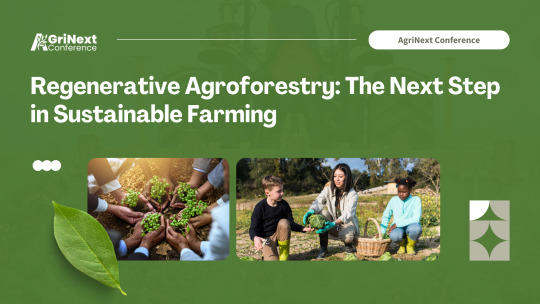
Discover how regenerative agroforestry combines farming and forestry to boost biodiversity, restore soil health, and create a sustainable future for agriculture
0 notes
Text
Precision Agriculture: Enhancing Crop Yields with Data
Introduction
Precision agriculture, a transformative approach to modern farming, leverages advanced technologies such as data analytics, artificial intelligence (AI), satellite imagery, and machine learning to enhance crop yields, optimize resource use, and promote sustainability. By integrating these tools, farmers can make informed decisions tailored to specific field conditions, ensuring higher productivity and reduced environmental impact.
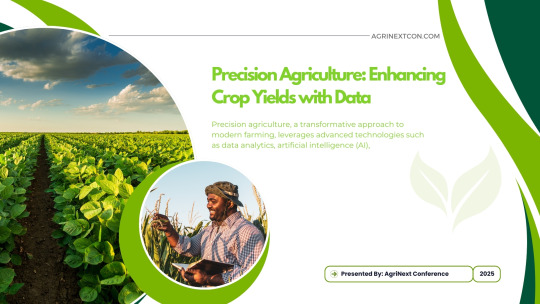
Key Technologies in Precision Agriculture
1. Data-Driven Insights
The foundation of precision agriculture lies in collecting and analyzing vast amounts of data from diverse sources like satellite imagery, soil sensors, weather stations, and drones. These insights enable:
Real-Time Monitoring: Farmers can assess crop health, soil moisture, and nutrient levels in real-time.
Predictive Modeling: AI-powered analytics forecast crop yields and detect potential threats like pest outbreaks or diseases.
Resource Optimization: Data-driven recommendations help farmers allocate water, fertilizers, and pesticides more efficiently.
2. Satellite-Based Technologies
Satellite imagery plays a pivotal role in precision agriculture by offering:
Crop Health Monitoring: Multispectral images calculate indices like NDVI (Normalized Difference Vegetation Index) to assess plant vigor.
Soil Moisture Analysis: Satellite data helps manage irrigation by identifying dry zones.
Stress Detection: Early identification of areas affected by pests or nutrient deficiencies.
3. Artificial Intelligence and Machine Learning
AI enhances decision-making through:
Yield Prediction: Machine learning models analyze historical and current data to predict yields with high accuracy.
personalized Advisory Systems: AI provides tailored recommendations for planting schedules, irrigation management, and pest control.
Automation: AI-powered machinery aids in tasks like identifying ripe crops or optimizing planting density.
4. Variable Rate Applications (VRA)
Precision agriculture enables variable rate applications of inputs such as:
Fertilizers: Adjusting application rates based on soil fertility maps.
Seeds: Optimizing planting density for different field zones.
Pesticides: Targeting specific areas to minimize chemical use while maximizing effectiveness.
Benefits of Precision Agriculture
1. Enhanced Crop Yields
Precision technologies can increase crop yields by up to 30% through better resource management and timely interventions. Predictive analytics ensure optimal planting and harvesting schedules, reducing risks associated with climate variability.
2. Resource Efficiency
By optimizing water usage through smart irrigation systems and reducing chemical inputs with targeted applications, farmers achieve significant cost savings while conserving resources. For instance:
Water usage can be reduced by 50% through precise irrigation techniques.
Input costs for fertilizers and pesticides may decrease by 15–20% without compromising productivity.
3. Environmental Sustainability
Precision farming minimizes the environmental footprint by:
Reducing soil degradation��through tailored land management.
Lowering greenhouse gas emissions via efficient resource utilization.
Promoting biodiversity through informed crop rotation practices.
4. Economic Growth
Precision agriculture contributes to rural economic development by:
Increasing farm profitability through higher yields and lower costs.
Creating jobs in agtech sectors like data analysis and equipment manufacturing.
Attracting investments in agricultural innovation.
Real-World Examples
John Deere’s Precision Farming Technology:Farmers using John Deere’s GPS-guided tractors and AI-driven analytics have seen yield increases of up to 15%, optimizing resource use and reducing waste.
The Netherlands’ High-Tech Greenhouses:
Dutch farmers leverage AI-controlled irrigation and climate management systems to achieve remarkable efficiency, producing up to 20 kg of tomatoes per square meter—twice the global average
India’s Digital Agriculture Initiatives:The Indian government, in partnership with tech firms, has rolled out AI-powered crop advisory systems that provide real-time insights to small-scale farmers, enhancing productivity and resilience.
Challenges and Future Outlook
While precision agriculture offers immense potential, challenges such as high initial costs, limited access to technology in rural areas, and the need for farmer training persist. However, as technologies become more affordable and accessible, the adoption of precision farming is expected to grow globally.
The future of agriculture will see greater integration of AI, IoT, and blockchain for improved decision-making and efficiency. Autonomous tractors and drones will enhance productivity while reducing manual labour. Hyper-personalized farming will optimize resource use for individual crops and livestock. Sustainability will remain a key focus, influenced by policy and regulatory shifts.
Precision Agriculture at AgriNext Awards,Conference & Expo 2025
AgriNext 2025, one of the premier agricultural technology conferences, will showcase the latest innovations in precision farming. The event will feature expert discussions on:
AI in Agriculture: How machine learning and automation are transforming crop management.
Smart Irrigation Solutions: Real-time water management strategies for sustainable farming.
Drone & Satellite Technology: The role of remote sensing in precision agriculture.
Data-Driven Decision Making: Leveraging big data for improved farm efficiency.
With leading agtech companies, startups, and industry experts presenting groundbreaking solutions, AgriNext 2025 will provide valuable insights for farmers, policymakers, and investors looking to adopt precision agriculture technologies.
Conclusion
Precision agriculture represents a paradigm shift in farming practices by combining traditional knowledge with cutting-edge technology. Its ability to enhance crop yields while promoting sustainability makes it a cornerstone for addressing food security challenges in an era of climate change and resource scarcity.
Reference:
Krishi yukta
#Precision Agriculture#Precision Agriculture Uae#Precision Agriculture Dubai#Precision Agriculture Conference
0 notes
Text
Drones in Agriculture: Revolutionizing Farm Monitoring and Crop Spraying
Introduction
Drones have revolutionized various industries, and agriculture is no exception. Drone farming represents the cutting edge of agricultural technology, promising efficiency, precision, and sustainability.The agricultural drone market is experiencing significant growth, with projections indicating it will reach approximately $3.37 billion by 2025.From scouting to security, drones are becoming common on both large and small farms. In many areas, drone use is already essential for large-scale precision farming operations.
Data collected by drones helps farmers optimize planting and treatment decisions, potentially increasing yields by up to 5% and making them a vital tool for modern agriculture.
How Drones Are Changing Agriculture
1. Precision Farming for Higher Yields
Drones equipped with advanced sensors and cameras can analyze soil health, plant growth, and irrigation needs in real time. Instead of relying on manual inspections, farmers can use drone imagery to detect nutrient deficiencies, pest infestations, or water stress across their fields.
Example: In India, startups like Garuda Aerospace and IoTechWorld Avigation are helping farmers optimize water usage and fertilizer application, reducing waste and increasing crop yields.
2. Real-Time Monitoring for Quick Decision-Making
Traditional farm monitoring methods involve walking across vast fields, which is time-consuming and inefficient. Drones provide an instant aerial view of the entire farm, helping farmers detect issues early. With thermal imaging and multispectral sensors, they can even monitor crop health at a microscopic level.
Example: The European Space Agency (ESA) partnered with agritech firms to use drones for predicting wheat production in France, helping farmers adjust strategies before harvest.
3. Automated Crop Spraying for Efficiency
Drones are revolutionizing crop protection by automating the spraying of pesticides, herbicides, and fertilizers. Unlike traditional methods, which rely on manual labour or large tractors, spray drones can target specific areas, reducing chemical use and minimizing harm to the environment.
Example: In China, the DJI Agras T30 drone is used extensively for rice farming, covering 40 hectares per day—a task that would take human labourers weeks.
Innovative Drone Applications in Precision Agriculture
Drone-Based Crop Monitoring by SenseFly
SenseFly’s eBee Ag drones have been widely used for precision agriculture, including in large-scale crop monitoring projects. For instance, in Argentina, farmers used SenseFly drones to analyze soybean fields, detecting early signs of disease and optimizing fertilizer application. This resulted in a 10% increase in yield and a 15% reduction in fertilizer costs. Similarly, in France, vineyard owners utilized SenseFly drones to map disease outbreaks, improving targeted treatment strategies and reducing chemical use.
PrecisionHawk: Drone Solutions for Agriculture
PrecisionHawk is a leading provider of drone technology for agriculture, offering advanced aerial data collection and analysis tools. Their drones use AI-driven analytics to assess crop health, monitor field conditions, and optimize resource management. By integrating high-resolution imaging and predictive analytics, PrecisionHawk enables farmers to make data-driven decisions, improving yields and reducing costs.
Smart Farming with High-Resolution Imaging
Drones and high-resolution imaging are becoming essential tools in smart farming. South African startup Aerobotics uses AI-powered drones to scan orchards and vineyards, detecting pests, diseases, and nutrient deficiencies. These drones provide early detection of issues, improving crop quality and yield predictions while saving farmers costs through targeted interventions.
Challenges and Future of Drone Technology in Agriculture
Despite their advantages, drones in agriculture face several challenges:
Regulatory Barriers: Many countries have strict laws on drone usage, requiring special permissions for agricultural applications.
High Initial Cost: Advanced drones with AI-powered analytics can be expensive for small-scale farmers.
Battery Limitations: Drones still have limited flight time, requiring frequent recharging for large farms.
However, the future looks promising. Companies like John Deere and AgEagle are investing in AI-powered drones capable of autonomous decision-making. With improvements in battery life, 5G connectivity, and machine learning, drones will soon become a standard tool in modern farming.
AgriNext Awards,Conference & Expo 2025: Showcasing the Future of Agri-Tech
AgriNext 2025, the premier agricultural technology event, will highlight the latest advancements in drone technology, AI-driven precision farming, and automation. Industry leaders, agritech startups, and policymakers will gather to discuss how drones and robotics are shaping the future of agriculture. With dedicated sessions on sustainability, smart farming, and climate resilience, AgriNext 2025 promises to be a crucial platform for exploring innovative solutions to modern agricultural challenges.
Conclusion
Drones are no longer just a visionary
concept—they are actively reshaping agriculture by making farming more efficient, sustainable, and data-driven. From real-time crop monitoring to precision spraying, these UAVs are helping farmers maximize yields while minimizing waste. As technology advances, the integration of AI, IoT, and robotics will push agriculture toward a future of fully automated, intelligent farming systems.
ResourcesLinks:
PrecisionHawk: Drone Solutions for Agriculture
DJI Agriculture: Drones for Farming
Agriculture Drones Market Size, Share & Trends Analysis Report
0 notes
Text
Natural Resources Management in Agriculture: Key Strategies for Sustainability
The importance of effective management strategies in agriculture, food, and natural resources cannot be overstated. As the global population continues to grow, the demand for food, water, and energy increases, putting pressure on the world’s natural resources. To meet this demand, it is essential to adopt sustainable and efficient management practices that ensure long-term productivity while minimizing environmental impact.
Agriculture relies heavily on natural resources like soil, water, and biodiversity. However, unsustainable practices have led to soil degradation, water scarcity, and biodiversity loss. Effective natural resource management (NRM) is crucial for ensuring agricultural sustainability while protecting ecosystems.
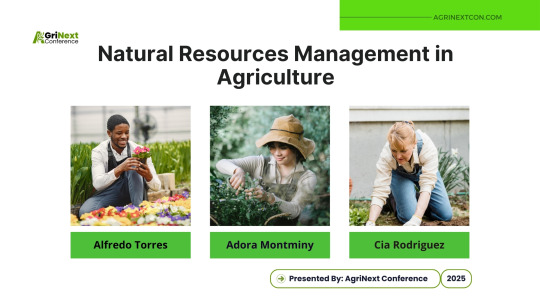
Key Strategies for Sustainable Natural Resource Management
Holistic approaches to conserving soil and water, reducing waste, and implementing effective policies enhance agricultural productivity while ensuring the planet’s long-term health. Below are key strategies to promote sustainability in agriculture.
1. Soil Conservation and Health
Soil is the foundation of agriculture. Sustainable soil management practices include:
Cover Cropping: Protects the soil from erosion and improves fertility.
Crop Rotation: Reduces nutrient depletion and breaks pest cycles.
Conservation Tillage: Minimizes soil disturbance, retaining organic matter.
Organic Amendments: Compost and manure enhance soil fertility naturally.
Example: The Organic Transition Initiative under the U.S. Farm Bill supports composting methods.
2. Water Management and Efficiency
Water is a limited resource, making efficient management critical for sustainable agriculture. Effective strategies include:
Precision Irrigation: Optimizes water use by delivering the right amount of water at the right time.
Rainwater Harvesting: Collects and stores rainwater to supplement irrigation needs.
Example: India’s Watershed Development Program encourages rainwater harvesting in rural areas.
Drought-Resistant Crops: Reduces dependence on extensive irrigation.
Example: The African Climate-Smart Agriculture Alliance (ACSAA) promotes drought-tolerant crops.
3. Biodiversity Conservation
Biodiversity is essential for maintaining ecosystem health and resilience. Sustainable strategies include:
Agroforestry: Integrating trees into agricultural landscapes promotes biodiversity and reduces erosion.
Conservation Agriculture: Practices such as reduced tillage and permanent soil cover protect soil biota.
Example: The Global Conservation Agriculture Program (GCAP) encourages conservation tillage worldwide.
Ecological Restoration: Restoring degraded ecosystems enhances biodiversity and ecosystem services.
Example: The UN Decade on Ecosystem Restoration aims to revive biodiversity by 2030.
Integrated Pest Management (IPM): Reduces reliance on chemical pesticides by using biological control methods.
Example: The FAO’s Global Action Plan on Fall Armyworm promotes IPM.
Pollinator Protection: Creating habitats for bees and other pollinators boosts crop yields.
Example: The EU Pollinators Initiative supports pollinator-friendly farming.
4. Climate-Smart Farming
Adapting to climate change is crucial for resource management. Key approaches include:
Regenerative Agriculture: Practices like carbon sequestration and no-till farming enhance soil health.
Example: The Carbon Farming Initiative in Australia offers credits for carbon sequestration.
Drought-Resistant Crops: Ensures food security in changing climates.
Example: India’s National Innovations in Climate Resilient Agriculture (NICRA) promotes climate-adaptive crops.
Precision Agriculture: Uses data-driven methods to optimize inputs and reduce waste.
5. Sustainable Energy Use
Energy efficiency reduces carbon footprints in farming. Strategies include:
Solar-Powered Irrigation: Reduces dependency on fossil fuels.
Example: India’s PM-KUSUM scheme subsidizes solar irrigation pumps.
Bioenergy from Waste: Converts agricultural residues into renewable energy.
Example: TheU.S. BioPreferred Program promotes bioenergy production.
Energy-Efficient Machinery: Lowers fuel consumption and emissions.
Example: The EU’s Green Deal encourages the use of low-emission farm machinery.
Key Policies Supporting Sustainable Agriculture
Government policies shape the agricultural sector’s sustainability efforts by providing financial support, promoting knowledge sharing, and setting sustainability benchmarks.
Common Agricultural Policy (CAP) – EU: Includes eco-schemes that reward farmers for sustainable practices.
Sustainable Farming Incentive (SFI) – UK: Pays farmers for adopting soil health and biodiversity measures.
Farm Bill (US): Funds conservation programs such as the Environmental Quality Incentives Program(EQIP).
Zero Budget Natural Farming(ZBNF) – India: Promotes chemical-free farming with government incentives.
African Climate-Smart Agriculture Alliance(ACSAA): Focuses on adaptation strategies for African farmers.
How Policies Incentivize Farmers
Financial Incentives: Grants for adopting eco-friendly technologies.
Example:EU’s Green Direct Payments.
Conservation Subsidies: Support for cover crops and no-till farming.
Example:USDA’s Conservation Reserve Program (CRP).
Agri-Environmental Schemes: Payments for reducing chemical use.
Example:England’s Environmental Land Management Scheme (ELMS).
Research & Extension Support: Government-backed agricultural R&D.
Example: India’s National Innovation on Climate Resilient Agriculture (NICRA).
Conclusion
Sustainable natural resource management is crucial for ensuring food security, ecosystem resilience, and climate adaptation. By implementing regenerative soil practices, precision irrigation, biodiversity conservation, and climate-smart policies, agriculture can thrive while safeguarding the planet.
With governments, farmers, and innovators working together, the future of farming can be productive and sustainable.
AgriNext Awards,Conference & Expo 2025 : Driving Innovation in Sustainable Agriculture
AgriNext plays a pivotal role in advancing sustainable natural resource management by showcasing cutting-edge solutions in precision irrigation, regenerative farming, and climate-smart agriculture. The event brings together industry leaders, policymakers, and agritech innovators to discuss the latest advancements in soil conservation, water efficiency, biodiversity protection, and renewable energy in farming.
0 notes
Text
Soil Health: The Foundation of Sustainable Farming and Food Security
Soil is the backbone of agriculture—a living, dynamic mixture of organic matter, minerals, water, air, and microorganisms that work together to support plant growth. This seemingly simple yet incredibly complex system sustains the food we eat every day. Healthy soil improves yields, promotes sustainable farming, protects the environment, and strengthens food security.
However, 33% of the world’s soil is already degraded, and over 90% could become degraded by 2050 if sustainable practices are not adopted (FAO, 2015a; FAO, 2020). This alarming trend poses a serious threat to future food production and highlights the urgent need to prioritize soil health.
In this blog, we’ll explore the importance of soil health and practical ways to keep soil fertile and productive for generations to come.
Understanding Soil and Soil Health
Soil is a fundamental component of life on Earth, playing a critical role in agriculture, ecosystems, and climate regulation. Over the past two years, the definition of soil has been carefully reviewed and refined by experts. The Soil Science Society of America (SSSA) previously defined soil as:
"The unconsolidated mineral or organic material on the immediate surface of the earth that serves as a natural medium for the growth of land plants."
However, in 2017, the SSSA Glossary working group revised this definition after extensive discussions. The final version, approved in August 2017, presents soil as a more dynamic system:
"The layer(s) of generally loose mineral and/or organic material that are affected by physical, chemical, and/or biological processes at or near the planetary surface and usually hold liquids, gases, and biota and support plants."
This definition emphasizes that soil is a living and evolving system rather than just an inert medium for plant growth.
What is Soil Health?
According to the USDA Natural Resources Conservation Service( NRCS)."Soil health is the continued capacity of soil to function as a vital living ecosystem that sustains plants, animals, and humans."
Soil health is assessed through key indicators such as organic matter content, microbial diversity, soil structure, water-holding capacity, and nutrient availability. These factors determine how well soil can support plant growth, resist erosion, and sustain long-term productivity.
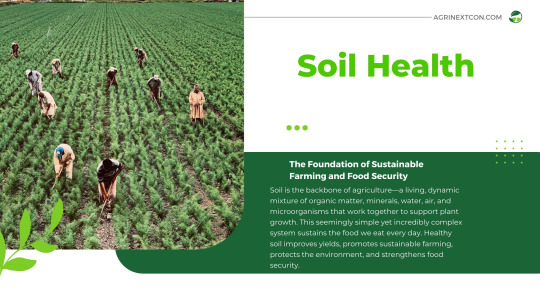
Understanding the Importance of Soil Health
Maintaining soil health is essential for sustainable agriculture, environmental protection, and global food security. Healthy soil supports plant growth, enhances water retention, promotes biodiversity, and acts as a natural carbon sink, helping to mitigate climate change. In contrast, poor soil management leads to declining crop yields, degraded water quality, and accelerated climate change.
However, land degradation is expanding by 1 million square kilometers annually, posing severe threats to climate stability, biodiversity, and food security (The Guardian). Additionally, drylands now constitute 40% of Earth's land area (excluding Antarctica), with increased aridity observed over the past three decades (The Guardian). These alarming trends highlight the urgent need for sustainable soil management practices.
With the global population projected to reach 10 billion by 2050, ensuring soil fertility is crucial for maintaining a stable food supply. Degraded soils result in lower agricultural productivity, making it increasingly difficult to meet rising food demands. By adopting sustainable soil management practices, we can protect soil fertility, strengthen ecosystem resilience, and sustain agricultural productivity for future generations.
Practical Ways to Maintain Soil Health
Farmers and gardeners can adopt several simple yet effective practices to preserve and enhance soil health:
1. Practice Crop Rotation
Growing the same crop continuously depletes specific nutrients and increases the risk of pests and diseases. Crop rotation—planting different crops in a sequence—improves soil structure, replenishes nutrients, and disrupts pest cycles.
2. Grow Cover Crops
Cover crops such as clover, rye, and legumes help prevent soil erosion, improve soil fertility, and enhance microbial activity. They also fix nitrogen in the soil, reducing the need for synthetic fertilizers. For example, farmers in the U.S. Midwest who use cover crops have reported a 30% increase in water retention and reduced fertilizer costs.
3. Reduce Tillage
Frequent tilling disrupts soil structure, accelerates organic matter loss, and increases erosion risk. No-till or reduced-till farming helps preserve soil integrity, retain moisture, and encourage beneficial microorganisms to thrive.
4. Add Organic Matter
Compost, manure, and plant residues enrich the soil with essential nutrients, improve its structure, and enhance moisture retention. Organic matter also feeds soil microbes, promoting a healthy and active soil ecosystem.
5. Implement Integrated Pest Management (IPM)
Instead of relying on chemical pesticides, IPM combines biological, cultural, and mechanical pest control methods. This reduces chemical contamination, preserves beneficial insects, and maintains soil health.
6. Monitor and Manage Soil pH
Soil pH affects nutrient availability. Most crops grow best in slightly acidic to neutral soil (pH 6.0–7.0). Regular soil testing and adjusting pH with lime (to raise pH) or sulfur (to lower pH) ensure optimal growing conditions.
7. Use Efficient Irrigation Techniques
Over-irrigation can lead to waterlogging, nutrient loss, and soil compaction, while under-irrigation stresses plants and lower yields. Using drip or sprinkler irrigation helps deliver water efficiently, maintaining soil moisture balance.
8. Promote Biodiversity
Encouraging plant and soil biodiversity strengthens soil resilience. Growing a variety of crops, planting native vegetation, and maintaining natural habitats for beneficial insects help sustain soil fertility and ecosystem balance.
Policies Supporting Soil Health
Governments and agricultural organizations worldwide recognize the importance of soil health and have introduced policies to promote sustainable farming practices. Some key initiatives include:
U.S. Farm Bill (EQIP & CSP): The Environmental Quality Incentives Program (EQIP) and the Conservation Stewardship Program (CSP) offer financial incentives to farmers adopting soil conservation methods like cover cropping, reducing erosion and improving fertility.
EU Common Agricultural Policy (CAP): The CAP supports sustainable agriculture by providing subsidies and grants for practices such as cover cropping and crop rotation to maintain soil health and biodiversity.
India’s Paramparagat Krishi Vikas Yojana (PKVY): This program encourages organic farming by providing financial support to farmers adopting natural soil health improvement methods, reducing reliance on chemical fertilizers.
By supporting these policies, farmers can enhance soil quality, improve yields, and contribute to long-term agricultural sustainability.
Conclusion
Soil health is the key to sustainable agriculture, environmental protection, and food security. By adopting soil-friendly practices, we can ensure long-term productivity, enhance resilience to climate change, and protect natural ecosystems. Maintaining soil health is not just a responsibility for farmers—it’s a collective effort that benefits the entire planet.
Governments, researchers, and consumers must collaborate to support policies and practices that restore and maintain healthy soils.
AgriNext Awards,Conference & Expo 2025: Paving the Way for the Future of Sustainable Agriculture
AgriNext 2025 is a premier event scheduled for November 5-6, 2025, in Dubai, United Arab Emirates. This conference aims to foster innovation in agriculture by showcasing cutting-edge technologies and sustainable practices. Attendees can expect to engage with industry leaders, explore advancements in AI-driven farming, precision agriculture, and sustainability, and participate in discussions shaping the future of global agriculture.
0 notes
Text
Where Agriculture Meets Innovation: 2025’s Key Events Across the Middle East, Africa & the World
Introduction
The Middle East and Africa are rapidly emerging as key hubs for agricultural innovation, with a strong focus on sustainability, agri-tech, and controlled-environment farming. From precision agriculture and automation to greenhouse and vertical farming, several major events are shaping the future of the industry. This guide highlights the top agriculture and horticulture events across the Middle East, Africa, and beyond, helping you stay updated on the latest trends, technologies, and opportunities in the sector.

Top Agricultural Events in the UAE & Middle East
1.AgriNext Awards,Conference & Expo 2025 – A Premier Agriculture Event
Date: November 5-6, 2025
Location: Dubai, UAE
Focus:A leading platform for sustainable farming, agri-tech, vertical farming, and precision agriculture, bringing together experts, startups, and investors to shape the future of food production.
2.Myplant & Garden Middle East
Date: November 15-17, 2025
Location: Dubai
Focus: A premier B2B green trade fair showcasing the entire ornamental plant and landscaping supply chain, including nursery plants, garden design, and urban green solutions
3.Horti Agri Next MEA
Date: November 25-27, 2025
Location: Abu Dhabi
Focus: Showcasing innovations in horticulture, food production, landscaping, and controlled environment agriculture.
4.AgraME
Date: October 6-7, 2025
Location: Dubai
Focus: AgraME is a leading agricultural trade show in Dubai, focusing on smart farming, sustainable water management, and agri-food innovation. It attracts global stakeholders in agri-tech, horticulture, and aquaculture.
5.AgroFarm Middle East
Date: October 6-7, 2025
Location: Dubai
Focus:AgroFarm Middle East is held alongside AgraME, focusing on livestock management and veterinary solutions.
6.Bahrain International Garden Show
Date: February 19-23, 2025
Location: Manama, Bahrain
Focus: A leading gardening and agriculture exhibition in the Arabian Gulf, featuring innovations in landscaping, horticulture, and sustainable farming.
7.The Saudi Food Expo
Date:April 21-24, 2025
Location: Riyadh, Saudi Arabia
Focus:A key event connecting global food suppliers with agricultural producers, highlighting trends in food security, sourcing, and agribusiness.
8.Saudi Agriculture
Date: October 20-23, 2025
Location: Riyadh, Saudi Arabia
Focus: A leading international exhibition covering agriculture, aquaculture, packaging, and agro-industry advancements.
9.Abu Dhabi Date Palm Exhibition:(ADDPE) 2025
Date: October 21-23, 2025
Location:ADNEC Centre, Abu Dhabi.
Focus:As the only global event dedicated to date palm cultivation and trade, it showcases innovations, fosters networking, and highlights sustainable farming practices.
Key Agriculture & Horticulture Events Worldwide
1.GreenTech Amsterdam
Date: June 10-12, 2025
Location: Amsterdam, Netherlands
Focus: A premier event showcasing cutting-edge horticulture technology, automation, and innovation for sustainable food production and early-stage cultivation.
2.Asia Fruit Logistica
Date: September 3-5, 2025
Location: Hong Kong
Focus: A key international platform for the fresh produce industry, covering supply chain advancements, logistics, and market trends.
3.Africa Agri Tech
Date: March 18-20, 2025
Location: Pretoria, South Africa
Focus:A leading event on agricultural technology and digital transformation, highlighting innovations in precision farming, automation, and climate resilience in South Africa.
4.Hortiflora Expo
Date: April 1-3, 2025
Location: Addis Ababa, Ethiopia
Focus:An international trade fair dedicated to floriculture and horticulture, showcasing the latest developments in flower and plant cultivation, greenhouse solutions, and exports.
5.The Garden Show Beirut
Date: May 2025
Location: Beirut, Lebanon
Focus: A specialized exhibition featuring gardening, landscaping, urban greenery, and outdoor design innovations for professionals and enthusiasts.
6.Agro + Agrotech Ethiopia
Date: May 9-11, 2025
Location: Addis Ababa, Ethiopia
Focus: A comprehensive expo on agricultural technology, smart farming, greenhouse solutions, and sustainable horticulture practices
7.International Floriculture Trade Expo (IFTEX)
Date: June 3-5, 2025
Location: Nairobi, Kenya
Focus: A global platform for the floriculture industry, connecting growers, exporters, and buyers to drive innovation in flower production and trade.
8.Garden Expo Africa
Date: October 9-11, 2025
Location: Casablanca, Morocco
Focus: A key event for landscaping, gardening technology, and sustainable outdoor solutions, catering to professionals and DIY enthusiasts.
9.Africa Agri Expo 2025
Date: February 19-20, 2025
Location: Nairobi, Kenya
Focus: This expo showcases the latest advancements in farm machinery, irrigation, greenhouse technology, and agrochemicals.
10.SIAM 2025 (Salon International de l'Agriculture au Maroc)
Date: April 21-27, 2025
Location: Meknes, Morocco
Focus: An international agricultural exhibition focusing on agriculture digitalization, supplies, food, breeding, machinery, and environmental sustainability.
Conclusion
Agriculture and horticulture in the Middle East and Africa are rapidly evolving, with a strong emphasis on sustainability, technology, and innovation. Events like AgriNext 2025, AgraME, and Horti Agri Next MEA provide a platform for industry leaders to discuss the future of farming, while specialized exhibitions in Africa and beyond highlight advancements in horticulture, floriculture, and controlled environment agriculture.
Attending these events offers valuable networking opportunities, insights into emerging trends, and access to the latest agricultural technologies. Whether you're a farmer, researcher, or agribusiness leader, these expos provide essential knowledge and connections to navigate the future of agriculture.
0 notes
Text
The Plant-Based Revolution: Sustainability, Innovation, and the Future of Food
Introduction
From supermarket shelves to fine dining, plant-based foods are no longer niche—they are transforming the global food landscape. Consumers are shifting towards healthier, more sustainable, and ethical diets, driving innovations in agriculture, food technology, and supply chains. With support from governments, food companies, and investors, plant-based alternatives are shaping the future of food security and environmental sustainability.
Market Growth and Potential
The plant-based food market is experiencing significant growth worldwide, fueled by rising consumer demand for sustainable and ethical food choices.
Global Market: Expected to exceed $100 billion by 2030, driven by health-conscious consumers, environmental concerns, and advancements in alternative proteins.
Middle East (MENA): Projected to grow significantly, supported by government investments, shifting dietary preferences, and increased product availability.
Middle East & Africa (MEA): The sector is expanding as more plant-based options enter the market, supported by policy changes and retail expansion.
Global Vegan Trends and Market Growth
The global transition to plant-based diets varies by region, influenced by culture, economy, and policy support:
Europe: Countries like Germany, the UK, and the Netherlands are leading in plant-based food sales, with strong government backing for alternative proteins.
United States: Flexitarianism and plant-based meat alternatives are becoming mainstream, with a growing share of consumers incorporating plant-based foods into their diets.
India: A significant portion of the population follows vegetarian diets, with increasing adoption of fully vegan lifestyles due to health trends and regulatory clarity (e.g., the Vegan Foods Regulations, 2022).
Key Growth Drivers
1. Health and Wellness Trends
The demand for nutrient-rich plant proteins like peas, lentils, chickpeas, and soy is rising as consumers seek healthier meat alternatives. This shift is driving:
Crop diversification, benefiting local farmers and boosting regional agriculture.
Reduced reliance on livestock farming, lowering greenhouse gas emissions.
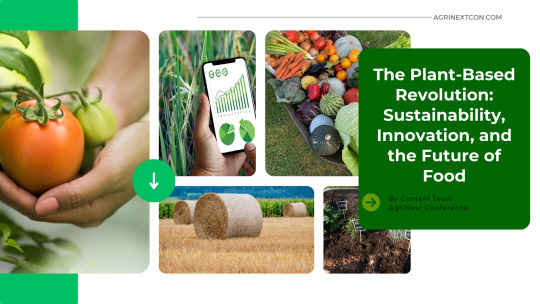
2. Sustainability and Environmental Awareness
Environmental concerns—including climate change, deforestation, and water scarcity—are accelerating the shift toward plant-based diets. These alternatives:
Support regenerative agriculture, improving soil health and biodiversity.
Reduce water and land use, making food production more sustainable.
Help combat deforestation by reducing reliance on feed crops like soy, commonly used for livestock.
In the Middle East, where water scarcity is a major challenge, plant-based agriculture is emerging as a climate-smart solution.
3. Government Support and Investment
Governments worldwide are backing plant-based innovations to enhance food security and sustainability:
UAE: The Food Tech Valley initiative and investment in food technology, including plant-based research, highlight the country’s commitment to sustainable food solutions.
India: The Food Safety and Standards Authority of India (FSSAI) introduced clear guidelines for vegan food production and labeling to ensure quality and transparency.
Global: Research funding in alternative proteins– such as lab-grown meat and precision fermentation is expanding, further accelerating the shift toward sustainable food production.
4.Expanding Product Availability – A Key Growth Driver
The rise of plant-based foods is reshaping supply chains and increasing demand for alternative proteins.
Global Brands Expanding in the Middle East: Companies like Beyond Meat, Danone, and Upfield are strengthening their market presence.
Regional Players Driving Growth:Brands such as Al Islami Foods (UAE) and Koita (Saudi Arabia) are launching plant-based alternatives tailored to local preferences and halal dietary needs.
Food Service as a Launchpad: Many global brands introduce plant-based products through food service before expanding into retail. In the UAE,Beyond Meat’s burger launched at Burger Fuel before becoming widely available in supermarkets.
The Middle East: A New Hub for Plant-Based IInnovation
The Middle East is emerging as a key player in the plant-based sector, creating opportunities for farmers, food producers, and agri-tech startups.
UAE & Saudi Arabia
TheUAE’s plant-based food market is projected to grow rapidly, driven by consumer interest and food security initiatives.
Dairy alternatives in the Gulf region are expanding, aligning with global trends in sustainable nutrition.
Saudi Arabia is seeing rising demand for vegan options, especially in urban centers.
Israel
A leader in alternative proteins and food tech innovation, Israel is attracting strong investment in lab-grown meat and precision fermentation. With UAE-Israel trade relations strengthening, cross-border collaboration in plant-based technology is expected to grow.
Consumer Concerns: Trust, Price, and Ingredients
While demand for plant-based foods is increasing, consumers in the Middle East prioritize:
Halal certification: Companies are launching halal-certified plant-based products to cater to Muslim consumers.
Affordability: Cost remains a key barrier, but scaling up production is expected to reduce prices over time.
Clean-label ingredients: A 2023 PwC
survey found that a significant portion of Middle Eastern consumers prefer plant-based foods with natural, recognizable ingredients.
The Future of Plant-Based Foods
As food security and sustainability become global priorities, plant-based solutions will play a crucial role in:
Reducing environmental impact.
Enhancing nutrition and dietary diversity.
Supporting climate-resilient agriculture.
Expanding alternative protein technologies, such as precision fermentation, vertical farming, and cultivated meat.
AgriNext Awards, Conferences &Expo 2025: Driving Innovation in Sustainable Food
AgriNext 2025 will showcase groundbreaking startups and innovations in plant-based and alternative proteins, reinforcing the UAE’s commitment to food security and sustainability. As a premier platform for industry leaders, researchers, and investors, AgriNext will drive critical discussions on the future of food production, shaping the next era of agriculture in the Middle East and beyond.
Conclusion
The rise of plant-based foods is not a passing trend—it is a fundamental shift toward healthier, more sustainable eating habits. With continued innovation, consumer awareness, and industry investment, plant-based solutions will play a crucial role in feeding the future, ensuring global food security, and supporting a more resilient agricultural system.
0 notes
Text
Quantum Agriculture: How Quantum Computing Can Solve Farming’s Biggest Challenges
Modern agriculture faces a growing set of challenges. Climate change is making weather patterns unpredictable, global supply chains are struggling with inefficiencies, and the need for higher crop yields is greater than ever. Traditional computing methods help farmers manage these issues to some extent, but they often fall short when dealing with highly complex agricultural systems. Enter quantum computing—a technology that has the potential to revolutionize farming by solving problems that today’s supercomputers struggle with.
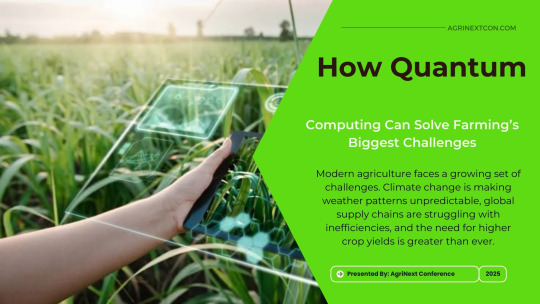
What is Quantum Computing?
Unlike classical computers, which process information in binary (0s and 1s), quantum computers use qubits, which can exist in multiple states at once. This allows quantum computers to perform calculations exponentially faster than traditional systems. In simple terms, while a classical computer solves one problem at a time, a quantum computer can explore multiple solutions simultaneously, making it ideal for solving complex, data-heavy problems—exactly what agriculture needs.
How Quantum Computing Can Transform Agriculture
One of the biggest applications of quantum computing in agriculture is climate forecasting. Farmers rely on weather predictions for planting and harvesting, but current models often fail to provide precise, long-term forecasts. Quantum computing can process massive amounts of climate data, improving weather prediction accuracy. With better forecasts, farmers can make smarter decisions about irrigation, fertilization, and pest control, reducing both waste and crop loss.
Another area where quantum computing can make an impact is crop genetics. Developing new crop varieties that are more resistant to drought, pests, or diseases is a slow and resource-intensive process. Quantum computing can rapidly analyze genetic patterns, helping scientists discover optimal genetic modifications for stronger, more resilient crops. This could lead to breakthroughs in plant breeding and the development of crops that thrive in extreme conditions.
Supply chain optimization is another challenge that quantum computing can help solve. In agriculture, inefficiencies in logistics lead to massive food waste. Perishable goods often get delayed due to poor planning, lack of real-time tracking, and unpredictable market demands. Quantum algorithms can analyze supply chain variables—weather conditions, transport routes, demand fluctuations—and create highly efficient logistics plans in real-time, reducing food waste and increasing profitability.
Is Quantum Agriculture Feasible Today?
Although quantum computing is still in its early stages, industries like pharmaceuticals, finance, and cybersecurity are already leveraging its power. While large-scale quantum agriculture projects are not yet mainstream, research is actively exploring its potential.
One notable initiative is the Optimizing Agricultural Operations with Quantum Computing project, led by Verge Ag in collaboration with D-Wave, PAMI, and the University of Northern British Columbia. This project applies quantum annealing and hybrid quantum-classical systems to improve agricultural planning and optimization. By integrating Verge Ag’s Launch Pad Platform with D-Wave’s Leap Quantum Cloud, the solution models complex agricultural scenarios at an unprecedented scale, helping farmers optimize field design, equipment usage, and crop planning. This technology aims to reduce operating costs, enhance yields, and promote sustainable farming.
Additionally, Classiq and Florence Quantum Labs have partnered to advance
precision agriculture using quantum-enhanced biosensors and AI-quantum hybrid algorithms. Their work focuses on ecosystem modeling, soil health monitoring, and nutrient management, contributing to more efficient and sustainable farming practices.
As quantum computers become more accessible, such real-world applications in agriculture will likely grow, paving the way for data-driven, high-efficiency farming.
Challenges of Implementing Quantum Computing in Agriculture
Despite its potential, quantum computing faces several barriers before it can be widely adopted in farming. First, cost is a major factor—quantum computers are expensive to build and maintain. Second, infrastructure and expertise are lacking, as most farmers and agronomists are unfamiliar with how quantum computing works. Finally, practical applications in agriculture are still being developed, meaning it may take years before quantum-powered solutions become available to farmers.
The Future of Quantum Agriculture
Imagine a future where farmers use quantum-assisted AI to make near-perfect decisions about planting, irrigation, and harvesting. With the ability to process vast amounts of environmental, genetic, and market data in seconds, quantum computing could lead to a more efficient, sustainable, and resilient agricultural system. While the technology is still developing, its potential to revolutionize farming is undeniable. As research progresses, quantum agriculture could become the key to solving the world’s most pressing food security challenges.
Conclusion
Quantum computing is still in its early stages, but its potential to transform agriculture is undeniable. From climate forecasting to crop genetics and supply chain optimization, quantum-powered solutions could revolutionize how food is grown, distributed, and managed. While challenges like high costs and infrastructure limitations remain, early initiatives—such as Verge Ag’s optimization project and AI-driven precision farming—show promising real-world applications. As technology advances and becomes more accessible, quantum agriculture could play a crucial role in creating a more efficient, resilient, and sustainable global food system. The future of farming isn’t just digital—it’s quantum.
AgriNext 2025: A Hub for Innovation in Agriculture
As emerging technologies like quantum computing reshape agriculture, industry events such as AgriNext 2025 play a crucial role in fostering innovation and collaboration.
AgriNext 2025 stands at the forefront of agricultural transformation, bringing together innovators, researchers, and industry leaders to explore cutting-edge solutions for sustainable farming. With a strong focus on AI, automation, and digital agriculture, the event highlights how emerging technologies—including quantum computing, precision farming, and blockchain—are driving efficiency, resilience, and sustainability in the agri-food sector.
As discussions on climate-smart agriculture and supply chain optimization take center stage, AgriNext 2025 serves as a vital platform for shaping the future of global agriculture.
0 notes
Text
Future of Farming: How Vertical Farming Reshaping Agriculture
Agriculture is evolving rapidly, and one of the most exciting innovations is vertical farming. With urbanization on the rise and arable land shrinking, growing food in vertically stacked layers using controlled environments is becoming a necessity. Vertical farms use hydroponics, aeroponics, and artificial intelligence (AI) to produce food more efficiently, using less water, no soil, and minimal land space.
Why Vertical Farming Matters

Vertical farming is revolutionizing agriculture by addressing some of the biggest challenges in food production. Water scarcity, land degradation, and climate change threaten traditional farming, but vertical farms offer a sustainable, high-efficiency alternative.
By growing crops in stacked layers under controlled conditions, vertical farms use 95% less water, require minimal land, and can be established in urban areas, warehouses, or shipping containers.These farms are independent of seasons, droughts, and unpredictable weather, ensuring year-round production.
Additionally, food is grown closer to consumers, reducing transportation costs and carbon emissions.
With the global population rising and arable land shrinking, vertical farming offers a scalable solution for future food security.

Types of Vertical Farming
Vertical farming comes in different forms, each with its own advantages:
1. Hydroponics – Plants grow in a nutrient-rich water solution instead of soil. This method is widely used due to its efficiency and reduced water usage.
2. Aeroponics – Roots are suspended in air and misted with nutrients. This system, developed by NASA, requires 90% less water than hydroponics.
3. Aquaponics – A hybrid system where fish and plants grow together. Fish waste provides nutrients for plants, while plants naturally filter the water for fish.
4. Modular Vertical Farms – Shipping container farms or mobile units designed for urban or remote locations. These offer customizable, plug-and-play solutions for fresh food production.
5. Skyscraper Farming – Large-scale, high-rise farms that integrate with urban buildings to maximize space and sustainability.
Each type has its own application, but all share the same goal: sustainable, high-yield farming in limited spaces.
Vertical Farming in Action: Case Studies from Around the World
1. Bustanica – The World’s Largest Vertical Farm
Dubai is home to Bustanica,the world’s largest vertical farm, developed by Emirates Crop One. Producing over 1 million kilograms of leafy greens annually, it operates with 95% less water than traditional farming. Strategically located, Bustanica strengthens food security in the UAE, a country reliant on 80-90% food imports.
2. Sky Greens (Singapore): Pioneering Skyscraper Farming
Sky Greens
Singapore, with its limited land for agriculture, has embraced skyscraper farming to enhance food production. Sky Greens, the world’s first low-carbon, water-driven rotating vertical farm, was developed in partnership with Singapore’s Agri-Food and Veterinary Authority (AVA).
Engineered by Jack Ng, the farm features 33-foot rotating aluminum towers with 38 tiers of vegetable troughs, maximizing yield while minimizing environmental impact. As Singapore prioritizes self-sufficiency, Sky Greens is a model for sustainable urban farming.
3. 80 Acres Farms (USA): Leading AI-Powered Vertical Farming
80 Acres Farms, a leading U.S.-based vertical farming company, uses AI, robotics, and Siemens-powered automation to grow pesticide-free produce year-round. Operating soil-free with hydroponics, its farms maximize efficiency while significantly reducing transportation-related carbon emissions.
4.Clover Ventures (India): Localized Climate-Smart Farming
Clover Ventures is pioneering climate-smart farming in India by integrating greenhouse and vertical farming models to produce high-value crops such as lettuce, herbs, and strawberries. Unlike large-scale vertical farms focused on mass production, Clover prioritizes a localized supply chain, ensuring fresh farm-to-table delivery for urban consumers.
By bridging the gap between technology and market demand, Clover Ventures is making vertical farming commercially viable in India while promoting efficient and localized food production.
5.UrbanKisaan (India): High-Tech Vertical Farming for Urban Spaces
UrbanKisaan, a Hyderabad-headquartered startup, is revolutionizing high-tech vertical farming in India. With soil-free, modular farms, it brings automated, high-yield farming to urban spaces. As a TechCrunch Disrupt Startup Battlefield finalist, the company is scaling its innovative approach across the country.
Vertical farming in India is still in its early stages, but UrbanKisaan is proving its economic and technological feasibility. With expansion plans across major cities, it is laying the foundation for a new era of precision-driven urban agriculture.
Why These Case Studies Matter
Each of these farms showcases a different approach based on geography, technology, and market needs. Whether through automation (80 Acres Farms), scale (Bustanica), or localized supply chains (Clover Ventures), they all contribute to a more resilient and sustainable food system.
Conclusion
Vertical farming is not just a trend—it’s the future of agriculture. With advancing technology, more countries will adopt automated, data-driven farms to address food security, water scarcity, and urbanization.
The case studies above show that whether in high-tech global farms, desert landscapes, or urban India, vertical farming is transforming the way we grow food.
AgriNext Awards, Conference & Expo
AgriNext Awards, Conference & Expo plays a crucial role in showcasing cutting-edge innovations in vertical farming, from AI-driven automation and hydroponic systems to large-scale skyscraper farms. The event brings together industry leaders, startups, policymakers, and investors, fostering collaborations that drive the future of sustainable agriculture. By highlighting emerging technologies, market trends, and investment opportunities, AgriNext serves as a platform to accelerate the adoption of next-generation farming solutions worldwide.
0 notes
Text
Top Agriculture, Vertical farming Agtech Events to attend in Dubai & Abu Dhabi in 2025
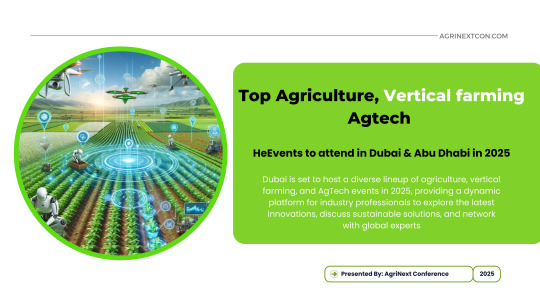
Introduction
Dubai is set to host a diverse lineup of agriculture, vertical farming, and AgTech events in 2025, providing a dynamic platform for industry professionals to explore the latest innovations, discuss sustainable solutions, and network with global experts. From groundbreaking advancements in precision farming and controlled environment agriculture to discussions on food security and climate resilience, these events cater to a wide spectrum of stakeholders in the agricultural sector. Whether you’re an investor, researcher, policymaker, or agribusiness professional, attending these events will offer valuable insights into the future of farming.
1. AgriNext Awards, Conference & Expo 2025: Farming the Future with Technology
Date: November 5–6, 2025
Venue: Dubai
Overview:
Following the success of the 2024 event, AgriNext returns to Dubai in 2025 as a premier platform for innovation, collaboration, and excellence in AgriTech. This dynamic event will bring together industry leaders, technology pioneers, policymakers, and investors to showcase cutting-edge advancements, address key agricultural challenges, and explore sustainable solutions. With a strong focus on smart farming, precision agriculture, and climate-resilient technologies, AgriNext 2025 aims to shape the future of modern agriculture and drive global agri-food transformation.
2. AgroFarm Middle East
Date: October 6–7, 2025
Venue: Dubai World Trade Centre
Overview: Co-located with AgraME, this event focuses on innovation in agriculture and related industries, aligning with the UAE’s vision for sustainable agriculture. It highlights advancements in animal farming, livestock, crop farming, horticulture, aquaculture, and water management.
3. AgraME
Date: October 6–7, 2025
Venue: Dubai World Trade Centre
Overview: A comprehensive agriculture event covering crop and horticulture, livestock and aquaculture, agritech, smart and sustainable farming, and water management. Designed for agri-food and farming professionals, it includes conferences and seminars.
4. Gulfood
Date: February 17–21, 2025
Venue: Dubai World Trade Centre
Overview: Celebrating its 30th edition, Gulfood will host over 5,500 exhibitors from more than 129 countries, it serves as a global platform for food innovation, trade, and networking in the agri-food industry.
5. AgroSummitX
Date: May 28-29 2025
Venue: Dubai
Overview: A global conference aiming to unite over 1,000 attendees, 300+ leading companies, and 70+ speakers from across APAC, Europe, Africa, and the Middle East. The event will feature discussions on critical global agricultural challenges, including sustainability, water scarcity, food security, and soil health.
6.Global Vertical Farming Show (GVF) 2025(GVF)
Date: September 10–11, 2025
Venue: Festival Arena Dubai
Overview: The Middle East’s premier event dedicated to vertical farming and controlled environment agriculture (CEA), connecting industry leaders, technology providers, and investors.
7. International Conference on Application of Innovative Technologies for Food Quality and Safety Dubai
Date: February 15, 2025
Venue: Dubai, UAE
Overview: This conference brings together researchers, scientists, and industry experts to discuss the latest advancements in food quality and safety. It serves as a platform for sharing innovations, regulatory updates, and best practices in ensuring food safety.
8.International Conference on Agricultural Sciences and Economics (ICASAE)
Date: June 16, 2025
Venue: Dubai, UAE
Overview: The International Conference on Agricultural Sciences and Economics (ICASAE) aims to bring together industry professionals, experts, academicians, and scholars to discuss their expertise for better collaboration in the field. The conference will cover a range of topics pertinent to agricultural sciences and economics, providing a platform for knowledge exchange and networking among professionals in the industry.
9. 2nd Global Summit on Food Science and Technology
Date: March 3–5, 2025
Venue: Dubai, UAE
Overview: The 2nd Global Summit on Food Science and Technology (FOODTECH 2025) will bring together global experts to explore advancements in food science, sustainable production, and emerging technologies. Organized by Apex Global Meetings, the event will feature discussions on food engineering, microbiology, safety, processing, packaging technologies, and nutritional science. Attendees will have the opportunity to engage with industry leaders, present research, and discover innovations shaping the future of food technology.
10. International Conference on Agriculture, Food Science, Forestry, Horticulture, Aquaculture, Biodiversity (ICAFFHAB)
Date: March 25, 2025
Venue: Dubai, UAE
Overview: A conference covering a broad spectrum of topics related to agriculture, food science, forestry, horticulture, aquaculture, and biodiversity.
11. International Conference on Sustainable Agricultural and Environmental Development (ICSAED)
Date: February 11 2025
Venue: Dubai
Overview: A conference focusing on sustainable agricultural practices and environmental development, promoting innovative solutions for sustainable farming .
12. AVF Academy in the UAE Winter 2025(AVF)
Date: February 3–5 and March 5–8, 2025
Venue: AgX Aerofarms Facility, Abu Dhabi, UAE
Overview: Organized by the Association for Vertical Farming (AVF) in cooperation with Khalifa University, this specialized training program in vertical farming will take place at the AgX Aerofarms Facility in Abu Dhabi, offering hands-on learning from industry experts.
13. Horti Agri Next MEA
Date: November 25–27, 2025
Venue:ADNEC ,Abu Dhabi
Overview:After a successful first edition in 2023, Horti Agri Next MEA returns to ADNEC, Abu Dhabi, from November 25–27, 2025, alongside VIV MEA 2025, the region’s leading event for livestock production, animal husbandry, and feed industries. This co-located event provides a comprehensive platform covering the entire agriculture supply chain, from horticulture and food production to animal protein and feed innovation, making it a must-attend for industry professionals.
In addition to these key events in 2025, the agricultural innovation scene in Dubai will continue into early 2026 with events like the World Agri-Tech MEASA Summit, further highlighting the region’s commitment to sustainable and tech-driven farming solutions.
14.World Agri-Tech MEASA Summit 2025
Date: January 26-27, 2026
Venue: Dubai
Overview: The World Agri-Tech MEASASummit provides a strategic forum for decision-makers and innovators to develop climate-smart strategies for sustainable food production. The summit will focus on building resilient agri-food systems in the Middle East, Africa, and South Asia, bringing together over 300 industry changemakers to discuss topics such as empowering smallholder farmers, increasing food yield and nutritional value, and reducing environmental impact through sustainable technologies.
Conclusion
Dubai’s 2025 agriculture and AgTech events present unparalleled opportunities for industry professionals to connect, collaborate, and stay ahead in an evolving landscape. With a strong focus on sustainability, food security, and technological advancements, these conferences and expos will shape the future of farming in the Middle East and beyond. Whether you’re looking to adopt new technologies, form strategic partnerships, or gain expert knowledge, these events are must-attend gatherings for anyone invested in the future of agriculture.
#Vertical farming#Vertical farming conference#Agtech events#Agtech events Uae#Agtech events dubai#Agtech events 2025
0 notes
Text
Top 10 Most Profitable Crops for Farmers in 2025
Agriculture remains one of the most profitable sectors globally, but choosing the right crop depends on climate, soil conditions, and market demand. In regions like India and the UAE, farmers are increasingly shifting toward high-value, sustainable, and export-oriented crops. Here's a look at the top 10 most profitable crops in India and the UAE, backed by market data and real-world examples.

1. Saffron – The 'Red Gold' of Agriculture
Saffron remains one of the most expensive spices globally, with prices ranging from $3,500 to $5,000 per kilogram. Leading producers include Iran, India (particularly Kashmir), Spain, and Afghanistan.
India: Kashmir continues to be India's primary saffron-producing region.
UAE: The UAE imports high-quality saffron from Iran and India and has initiated small-scale indoor saffron farming projects.
2. Dates – The UAE’s Agricultural Treasure
Dates are a staple food in Middle Eastern cuisine and a major export commodity, selling for $2–$5 per kg. Top producers include Egypt, Iran, Algeria, Saudi Arabia, and the UAE.
UAE: The UAE ranks among the top 5 date-producing countries, exporting to Europe and Asia.
3. Mushrooms – High Demand, Quick Returns
Exotic mushrooms like shiitake, oyster, and morels fetch between $15–$50 per kg. Top producers include China, the USA, the Netherlands, Poland, and India.
India: States like Himachal Pradesh and Punjab have thriving mushroom industries.
UAE: Mushroom farming is expanding in controlled environments, with hydroponic and container-based methods making cultivation viable in desert conditions.
4. Herbs (Basil, Mint, Oregano, Rosemary) – Growing Organic Market
Fresh organic herbs are in high demand, selling for $10–$30 per kg. Top producers include Italy, the USA, India, Egypt, and Turkey.
India: Tamil Nadu and Kerala lead in herbal cultivation for Ayurveda and exports.
UAE: Hydroponic farms like Pure Harvest and Badia Farms produce high-quality basil and mint for local markets.
5. Millets – The Rising Superfood Trend
With increasing health consciousness, millets are becoming popular alternatives to rice and wheat, selling for $1–$3 per kilogram. Top producers include India, Nigeria, China, Niger, and Mali.
India: The government declared 2023 the International Year of Millets, boosting production in states like Rajasthan and Karnataka.
6. Avocado – The Superfood Boom
Avocados are in high demand, selling for $2–$4 per fruit. Top producers include Mexico, the Dominican Republic, Peru, Colombia, and Indonesia.
India: Small-scale cultivation is growing in Kerala and Karnataka, focusing on exports.
UAE: Avocados are mainly imported, but hydroponic projects are exploring local production.
7. Hydroponic Lettuce & Leafy Greens – Perfect for Urban Farming
These crops grow faster than traditional methods and offer higher yields per square meter. Top producers include the Netherlands, the USA, China, Japan, and the UAE (for controlled farming).
India: Hydroponics is gaining popularity in Bengaluru, Pune, and Delhi NCR.
UAE: Companies like Green Fields and Smart Acres are producing lettuce, kale, and spinach using vertical farming techniques.
8. Dragon Fruit – A New High-Value Crop
Dragon fruit is a low-maintenance crop with high demand, selling for $3–$7 per fruit. Top producers include Vietnam, Colombia, Ecuador, Thailand, and India.
India: Gujarat and Maharashtra are leading in commercial dragon fruit farming.
UAE: Locally grown dragon fruit is becoming popular in Dubai's premium supermarkets.
10. Quinoa – The Next Big Superfood
Quinoa is high in protein and sells for $4–$10 per kg. Top producers include Peru, Bolivia, Ecuador, the USA, and Canada.
India: Rajasthan and Madhya Pradesh are expanding quinoa production.
UAE: Desert farming initiatives are testing quinoa as an alternative to wheat.
10. Ginger – High Demand in Culinary and Medicinal Markets
Ginger is a versatile crop with applications in both culinary and medicinal fields, selling for $6–$8 per kilogram. Top producers include India, China, Nigeria, Nepal, and Indonesia.
India: As a leading producer, India cultivates ginger extensively in states like Kerala, Karnataka, and Meghalaya.
UAE: While primarily imported, there's potential for controlled environment agriculture to meet local demand.
Conclusion
In the evolving landscape of agriculture, profitability depends on adaptability, market trends, and technological advancements. In India, crops like saffron, millets, and ginger thrive due to diverse agro-climatic zones and strong traditional practices. In the UAE, innovations in hydroponics and drought-resistant crops like dates and quinoa are shaping the future of sustainable farming.
At AgriNext 2025, , experts will delve into hydroponics, precision farming, and resilient crop varieties, providing farmers with actionable insights to enhance productivity and profitability in an ever-changing agricultural sector.
References
1. Salam Kisan – Insights on high-value crops and market trends. https://www.salamkisan.com/
2. Tend – Data on profitable farming practices and technology. https://www.tend.com/
#Crops for Farmers#Farming conference#Farming conference 2025#Farming conference Uae#Farming conference Dubai
1 note
·
View note
Text
From Rooftops to Vertical Farms: How Urban Agriculture is Reshaping City Life
Urban agriculture is revolutionizing city life by creating green spaces, improving food security, and fostering community engagement. As urbanization accelerates, smart and sustainable farming practices are emerging worldwide, redefining how food is produced and consumed in cities.
According to Expert Market Research, the smart agriculture market is projected to grow at a CAGR of 9.2% from 2025 to 2034, potentially reaching a valuation of USD 44.18 billion by 2034. This trend underscores the global shift towards urban farming as cities seek innovative solutions for sustainable food production.

A Global Movement
In 2024, urban agriculture has become a global phenomenon, with over 800 million people engaged, according to the FAO. This movement is particularly visible in:
China, where urban farming is expanding rapidly in metropolitan areas like Beijing and Shanghai, with 20 million square meters of rooftop gardens.
The United States, where initiatives like Brooklyn Grange : A rooftop farm network that produces over 100,000 pounds of organic food annually.
India, where urban gardens in Mumbai and Delhi contribute to 60% of fresh vegetable needs in some areas.
Singapore, a leader in vertical farming, using advanced techniques to boost local food security.
Germany, where cities like Berlin are converting vacant lots into community gardens, strengthening local food networks.
The United Arab Emirates, where large- scale vertical farms like ECO 1 in Dubai are using AI and hydroponics to grow fresh produce in arid conditions.
Urban Agriculture Success Stories
China: Vertical Farming Innovations
China is actively incorporating urban agriculture into national policies. Inspired by Singapore’s Sky Greens model, major cities like Beijing and Shanghai have transformed rooftops into farms, producing up to 1,000 kg of vegetables daily. According to the Chinese Academy of Agricultural Sciences, urban farms could contribute 15% of China’s vegetable supply by 2030.
United States: Urban Farming Boom
The U.S. is witnessing significant growth in urban agriculture, with cities investing in community gardens and vertical farms.
Brooklyn Grange (New York City): A rooftop farm network producing 100,000+ pounds of organic food annually.
Los Angeles Urban Farming Company: Converts abandoned lots into productive farms, yielding 500,000+ pounds of fresh produce yearly.
India: Rooftops to Gardens
Urban agriculture is gaining popularity in Mumbai and Delhi, where it helps address food insecurity.
Urban Leaves (Mumbai):
Urban Leaves is a Mumbai-based initiative that converts rooftops and unused urban spaces into thriving organic farms. By promoting permaculture techniques and community engagement, it empowers city dwellers to grow their own fresh produce, enhancing food security in urban areas.
National Horticulture Board: Reports that urban farming could support 40% of urban households between 2025 and 2034.
United Kingdom: A Green Revolution
The UK is advancing urban farming through initiatives like London’s Urban Food Strategy, aiming to increase local food production by 2030. The Greater London Authority suggests that if every resident grew just one tomato plant, the city could produce over 2 million tomatoes annually.
Brazil: Urban Agriculture for Social Impact
In São Paulo and Rio de Janeiro, urban farming initiatives are turning vacant lots into thriving community gardens. Projects like the Hortas Cariocas program provide fresh produce to low-income neighborhoods while promoting environmental sustainability and social inclusion.
Japan: Farming in Harmony with Nature
Tokyo’s "Parks for People" integrates urban farming into public spaces, enabling communities to grow food in shared gardens. Hydroponic farms in Tokyo are reportedly 10 times more productive than traditional farming methods, according to the Tokyo Metropolitan Government.
UAE: A Leader in Vertical and Urban Farming
The United Arab Emirates (UAE) is at the forefront of urban and vertical farming, addressing water scarcity, extreme temperatures, and reliance on food imports. With over 90% of its food imported, the UAE has prioritized high-tech farming solutions such as hydroponics, aeroponics, and AI-driven agriculture to secure its food future.
Key Urban Farming Initiatives in the UAE
ECO 1 : The World���s Largest Vertical Farm
A joint venture between Crop One Holdings and Emirates Flight Catering, Dubai’s ECO 1 is a 30,000-square-meter vertical farm producing 900+ tonnes of leafy greens annually while using 95% less water.
Badia Farms :The UAE’s First Urban Vertical Farm
Established in 2016, Badia Farms grows microgreens and herbs using hydroponic techniques, supplying top Dubai restaurants with pesticide-free produce.
Plenty & Mawarid Ventures: Expanding Vertical Farming
In 2024, U.S.-based Plenty partnered with Mawarid Ventures to create a $680 million joint venture, establishing five vertical farms in the Middle East, including a strawberry farm in Abu Dhabi.
Pure Harvest Smart Farms: AI-Powered Agriculture
Abu Dhabi-based Pure Harvest has developed AI-controlled greenhouses that optimize temperature, humidity, and irrigation to grow high-yield crops in desert conditions.
The Future of Urban Agriculture in the UAE
The UAE government is driving urban agriculture through the National Food Security Strategy 2051, supporting agritech startups and sustainable farming projects. With continuous investments in AI-driven vertical farms, the UAE is setting a global benchmark for smart agriculture in arid regions.
Conclusion
Urban agriculture is reshaping cities worldwide, promoting sustainability, food security, and local resilience. From vertical farming in China to community gardens in Brazil, cities are adopting innovative food production models.
In the UAE, urban agriculture is a strategic priority, with large-scale vertical farms, AI-powered greenhouses, and government-backed initiatives driving progress. As technology advances, the UAE is emerging as a global leader in sustainable urban farming, setting a benchmark for future food security
AgriNext Awards,Conference & Expo 2025: A Hub for Urban Agriculture Innovations
AgriNext 2025 will spotlight cutting-edge urban agriculture solutions,bringing together experts, startups, and industry leaders to explore sustainable urban farming solutions. The event will highlight advancements in vertical farming, hydroponics, and smart urban greenhouses, addressing food security and environmental challenges. With live demonstrations and expert panels, AgriNext 2025 will be a key platform for shaping the future of urban food production.
#Rooftops to Vertical Farms#Vertical Farms#Vertical Farming Conference#Vertical Farming Conference dubai#Vertical Farming Conference 2025
0 notes
Text
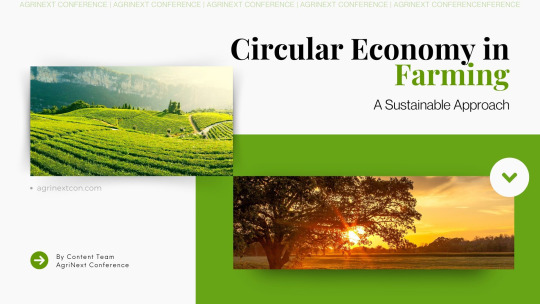
Discover how the circular economy in farming promotes sustainability, reduces waste, and enhances resource efficiency for a greener agricultural future
0 notes
Text

Promote the latest farming methods and encourage agriculture sector we are agrinxext organizing Biggest Agriculture Event in Dubai on 13 - 14 Nov 2024. If you are working in a faring field register now.
https://agrinextcon.com/
0 notes